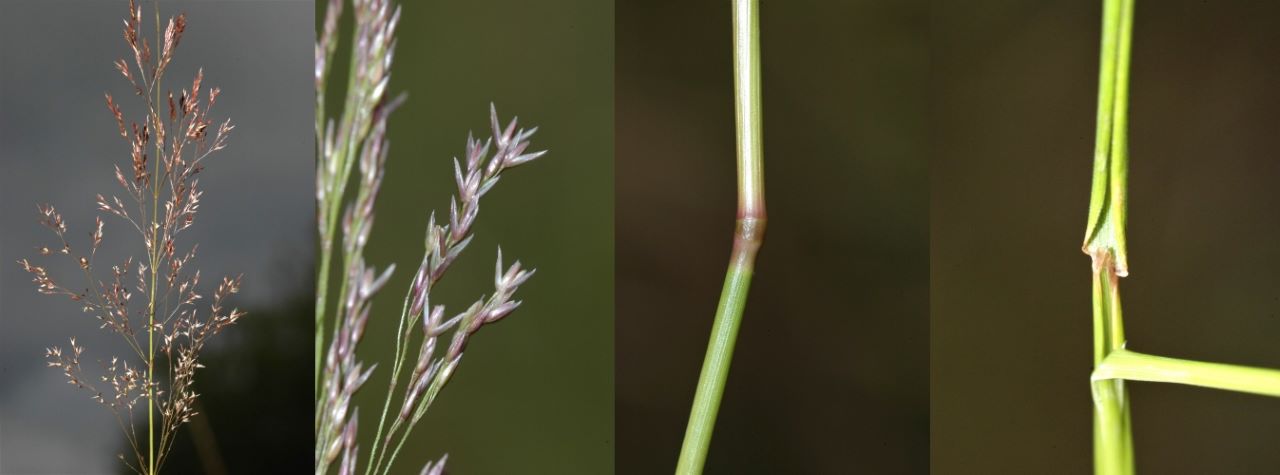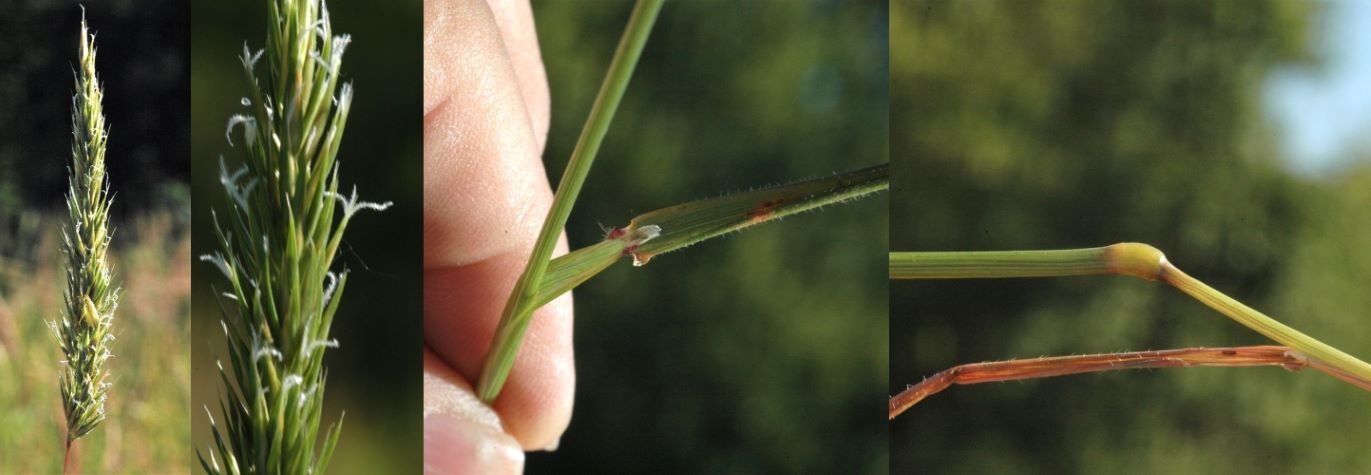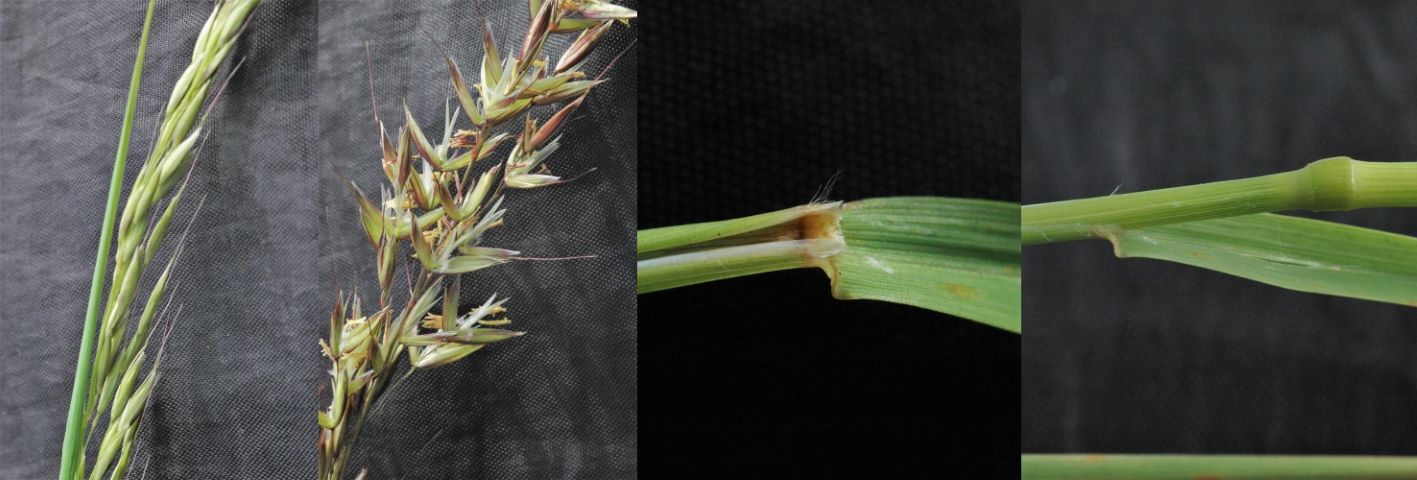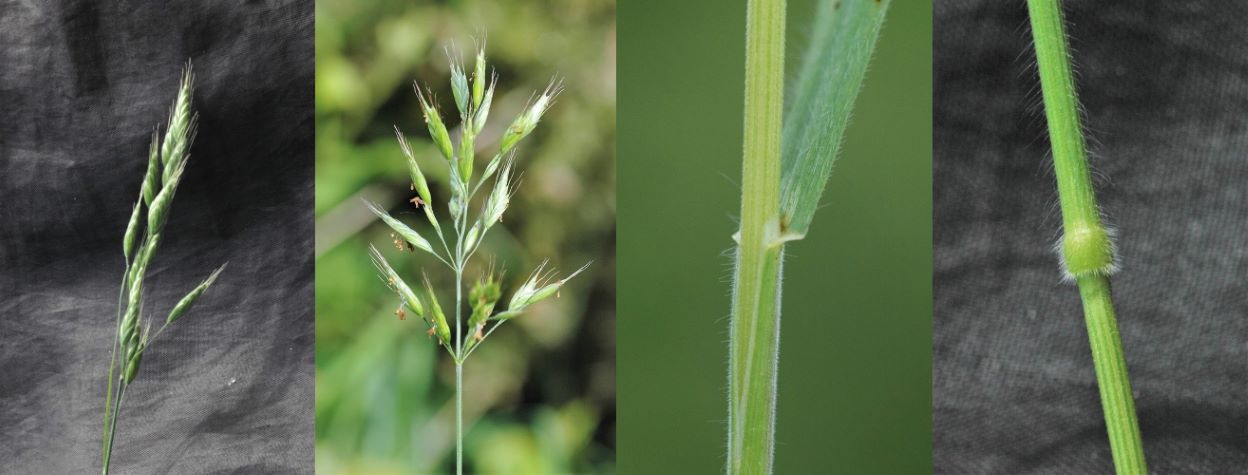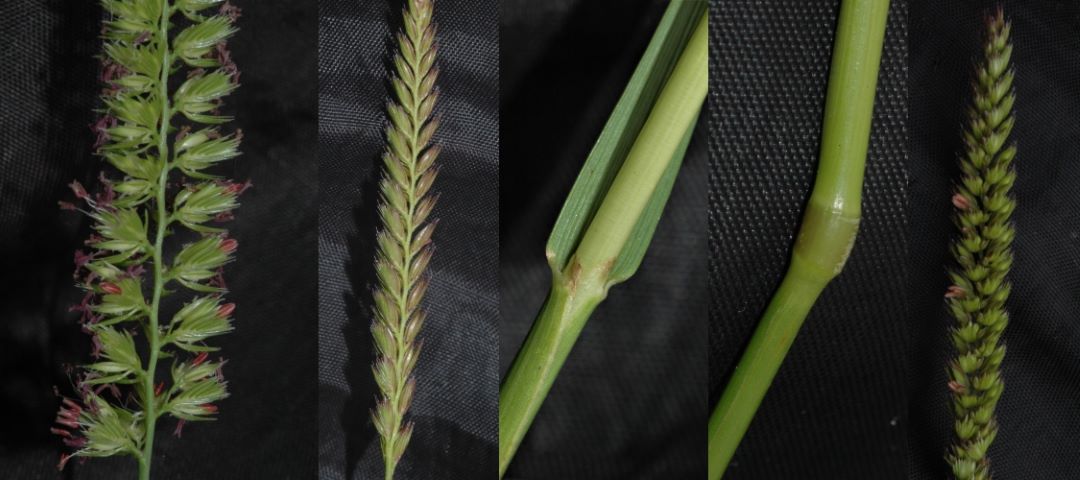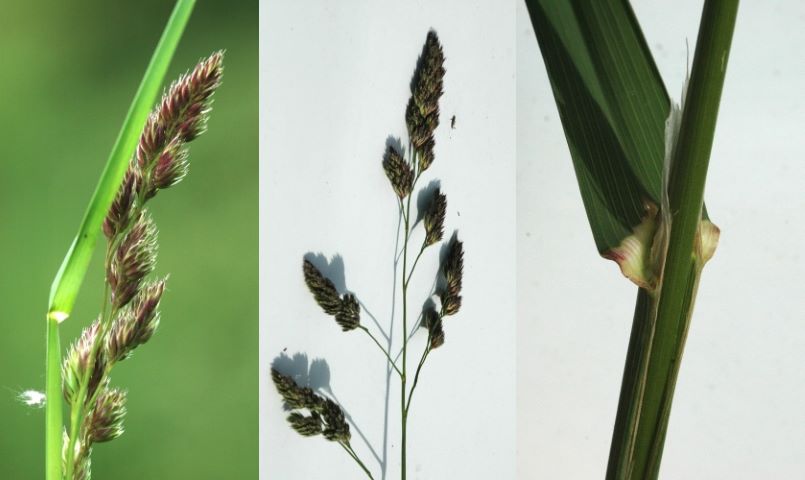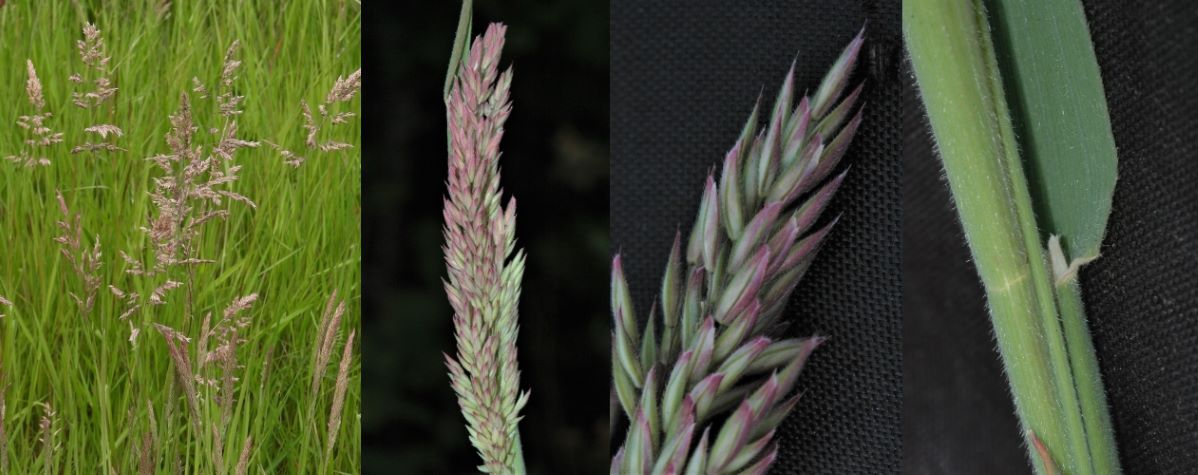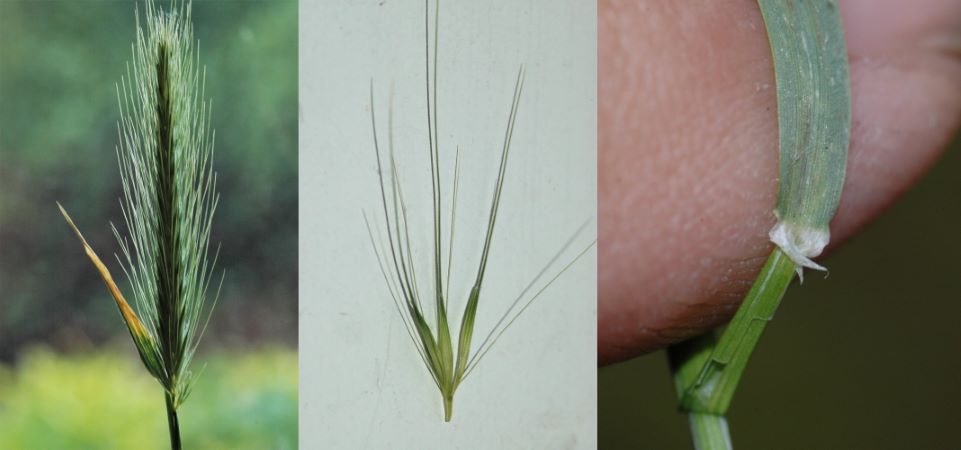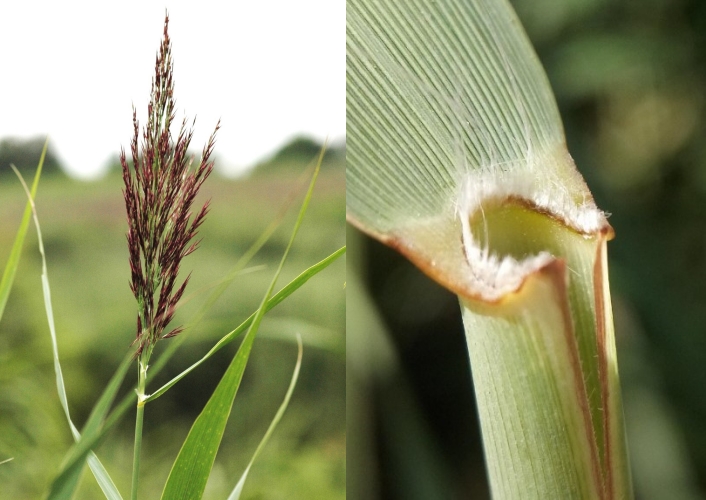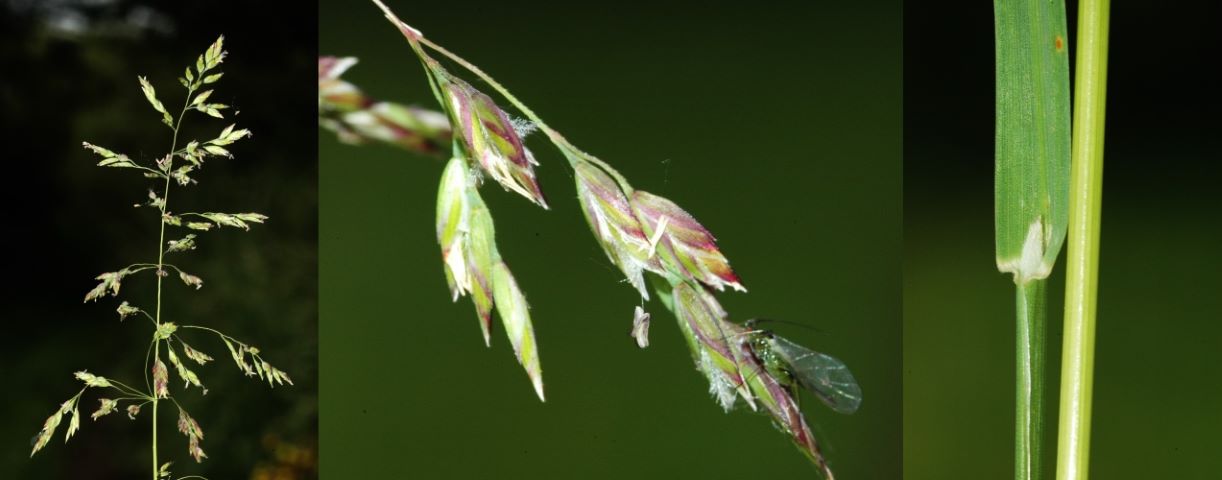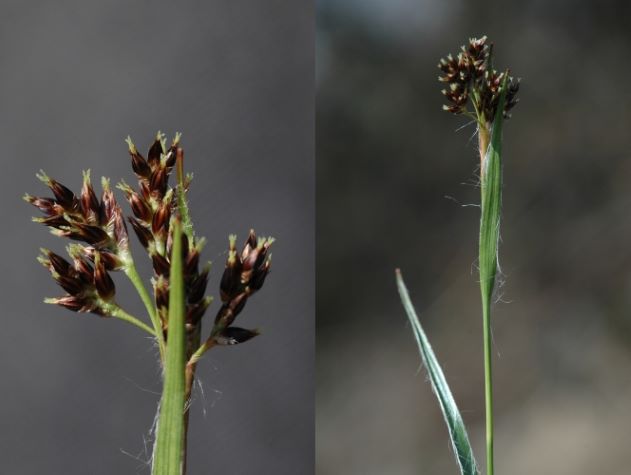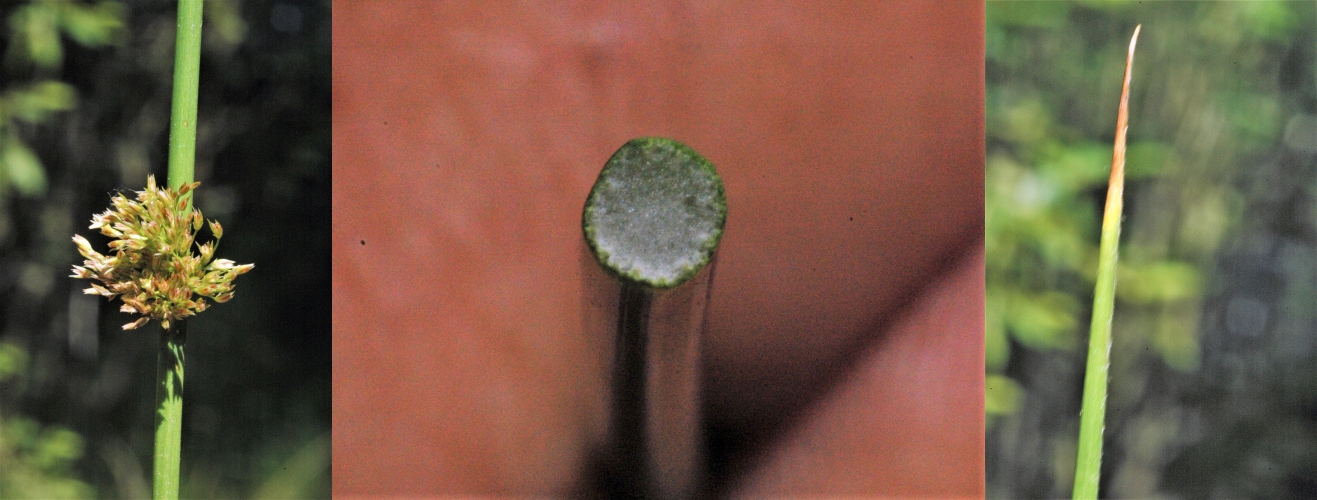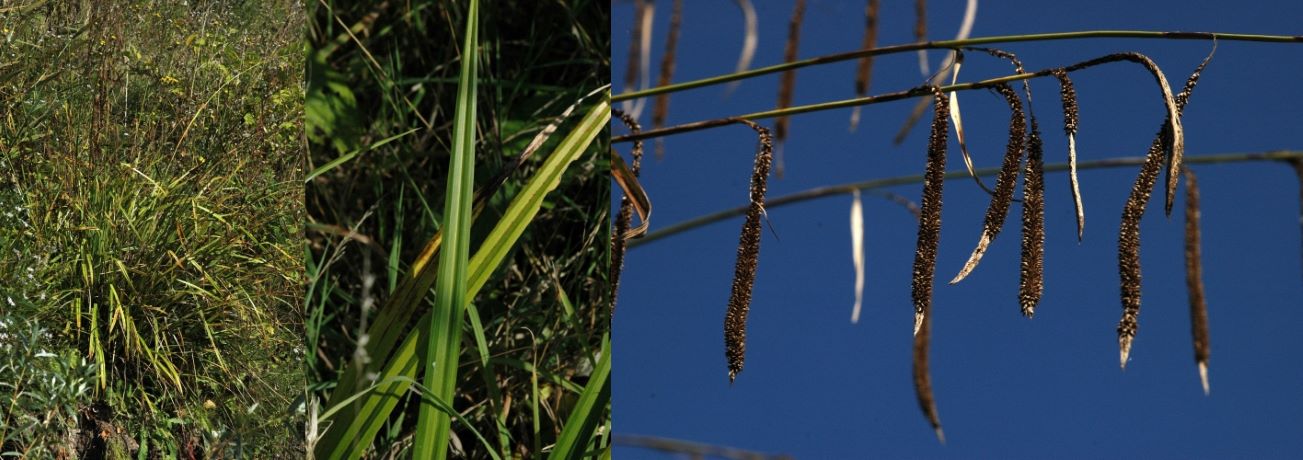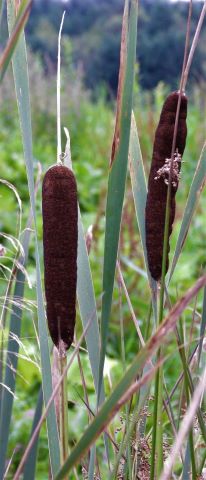This section records the many, green, non-woody plants belonging to the grass family (Poaceae), the sedge family (Cyperaceae), and the rush family (Juncaceae) which have been identified on the Reserve. In addition to this general definition of grass-like plants we have added the family (Typhaceae) which are few in number as a convenient place to record them. There are currently 37 species of Grass, 8 species of Sedge, 8 species of Rush and a single species of Typha recorded on the Reserve.
- The most obvious anatomical differences of these three families are:
- Grass stems have nodes (joints) and tend to be round and hollow.
- Grass stems have leaves.
- Sedge have solid not hollow stems.
- Sedge stems are triangular in section, easiest to spot towards the base.
- Sedge do not have nodes on the stems.
- Rushes have slender unjointed round stems.
- Rushes have flowers with three outer and three inner tepals (tepals are flower structures which have no differentiation between sepals or petals).
- Rushes produce fruits called capsules which contain either three seeds or numerous seeds dependent on the two genus the species belongs.
Grasses, Rushes, Sedges & Typha Species List Recorded at Woolston Eyes rev.2022
The sparse records for most of this order is probably more to do with disinterest and lack of identification skills than the rarity of the species but currently we just do not know. Copies of the records used to compile this list are viewable below.
- 2021-2022 A Year Record of Species Photographed on No.1 bed - John Blundell & David Riley
- 2013-2018 List of Flora Recorded on Woolston Eyes - Margaret Rawlins & Colleagues
- 1996 A Survey List of the Grasses, Sedges & Rushes on Woolston Eyes - Mik Lees & Colleague
- 1985 WECG Management Plan Appendix 1 - List of Flora on Woolston Eyes
- 1983 WECG Annual Report - Some Plants of the Eyes Duncan McNaughton
- 1980 Ecological Survey of Woolston Eyes - Warrington New Town Corporation Flora List
G01 Brown Bent Grass (Agrostis canina)
Status: Prefers damper more acidic grassland and water margins. One of the least common “Bent’s,” flowers from May to August.
John Blundell No.1 bed 29/06/2022
G02 Common Bent Grass (Agrosti capillaris)
Photo: 1. Flower to 500mm tall in an open whorled branched panicle, purple-green in colour. 2. Close view, the spikelets have no awns and only contain one floret each but the covering sheaths (glumes) spread on maturity and give it a false triple appearance. 3. The stem and nodes are round and hairless. 4. Non-flowering leaf sheath has no auricles and a ligule wider than tall.
Status: Common throughout Britain, flowers June to August and prefers drier and generally nuetral to acidic habitats.
G03 Creeping Bent Grass (Agrostis palustris)
Status: Common in Britain likes damp ground and flowers June to August.
John Blundell No.1 bed 08/06/2022
G04 Couch Grass (Agropyrum repens)
Photo: 1. Flowerhead erect 40-100mm, spikelets arranged tightly alternate with no awns. 2. Leaf, a flat blade 5-10mm wide with parallel lines and sparse long hairs. 3. Stem round and smooth, leaf sheath has wide short ligule and auricles which curl around the stem.
Status: Very common across the UK, flowers June to August.
G05 Early Hair-grass (Aira praecox)
Status: Common but localised in Britain, prefers dry areas, often sandy or rocky, flowers April to June.
G06 Meadow Fox-tail Grass (Alopecurus pratensis)
Status: Very common in Britain in varied habitat. flowers April to June.
G07 Marram Grass (Ammophila arenaria)
Status: 2m tall grass associated with beaches, sand dunes and the seaside grows in sandy places. A single report for the Reserve of this species is recorded from 1983
G08 Barren Brome (Anisantha sterilis)
Status: Common throughout Britain on dry grassland, wasteland, hedgerows etc. from May to June.
John Blundell No.1 bed 20/06/2022
G09 Sweet Vernal-grass (Anthoxanthum odoratum)
Photo: 1. Flower to 600mm tall in cylindrical spikes around 50mm long are dark when young but turn greyer-green. 2. The spikelets have three feathery white hairs projecting from the tip. 3. The leaf is a flat blade which often curls inward at the edges is hairy underneath and the leaf sheaths have long, 5mm, ligules. 4. Stem is round and smooth.
Status: Common in Britain, prefers acidic habitats and flowers April to July - an early flowering species.
John Blundell No.1 bed 15/06/2022
G10 False Oat (Arrhenatherum elatius)
Photo: 1. To a metre tall, panicle loosely branched, 200mm long, spikelets green-purplish, each has a projecting awn (hair) as long as the spikelet and angled after 1/4 of its length. 2. spikelet glumes (bracts) at maturity open & pale. 3. Leaves long to 400mm slightly hairy, rough, sheath ligule is broad and short, no auricles. 4. round & smooth stem.
Status: Very common in Britain, flowers June & August.
G11 Ornamental Quaking Grass (Briza maxima)
Status: the species was first recorded in 2013 on a plant survey by Margaret Rawlins and colleagues. The plant was found in the meadow birdseed crop which is sown each year to supplement bird feeding in the late autumn and winter periods. It has not been recorded since. This is more to do with surveying commitment than presumed absence of the species.
John Blundell No.1 bed 15/06/2022
G12 Meadow Brome (Bromus commutatus)
Photo: 1. Early flower inflorescence. 2. Mature flower inflorescence showing whorled branched spikelet ovoid shape and awns (hairs). 3. Leaf sheath showing shorter than wide blunt ligule, no auricles and softly hairy flat leaf. 4. Stem & node showing round shape and softly hairy nature.
Status: Fairly common in England, found in arable land, meadows, verges and wasteland. Flowers June to September.
G13 Common Soft-brome (Bromus hordeaceus)
Status: Common throughtout Britain on drier grassland, flowers June to August.
G14 Wood Reed-grass (Calamogroatia epigeios)
Status: Common across southern , central and eastern England. widespread but localised elsewhere. Flowers June to August can tolerate both dry and wet habitats.
John Blundell No.1 bed 15/06/2022
G15 Crested Dog's-tail (Cynosurus cristatus)
Photo: 1. Flower spike is dense circa 50mm long and is one-sided. 2. Reverse side of flower head is flat with all flowers facing out. 3. Leaf is a flat blade and ribbed on the upper face, leaf sheath has no auricles and the ligule is long and blunt tipped. 4. Stem and node are round and smooth. 5. Flowers from the reverse, flat, side.
Status: Very common across Britain in general grassland habitat, prefers drier conditions and neutral soils. Flowers June to August.
John Blundell No.1 bed 23/05/2022
G16 Cock's-Foot (Dactylis glomerata)
Photo: Tall, to 1 metre and stiff. 1. Young flower inflorescence, erect circa 50-100mm long and green tinged purple. 2. Mature flower spike showing usual triangular form, a few lower branches alternate and a longer end branch ending in tight clusters of spikelets. 3. Leaf a stiff grey-green flat blade, rough, hairless and ribbed with no auricles and a long ligule . Stem is round and hairless.
Status: Very common in Britain, flowers May to August.
G17 Tufted Hair-grass (Deschampsia caespitosa)
Status: Inhabits any type of grassland but prefers poorer drained ground, flowers June to August.
G18 Wavy Hair-grass (Deschampsia flexuosa)
Status: Prefers drier free draining ground, birch and oak woodland, but not chalk or limestone. Common in western Britain, scarcer in the south and east. Flowers June and July.
G19 Tall Fescue (Festuca arundinacea)
Status: Widespread and frequent in Britain. Prefers damp ground, meadows, ditches, river banks etc. flowers June to August.
G20 Sheep's Fescue (Festuca ovina)
Status: Common in most of Britain except the south-east on drier ground. Flowers May to July.
G21 Meadow Fescue (Festuca pratensis)
Status: Fairly common in most of Britain except Scotland in a wide range of neutral habitats, prefers fertile ground and flowers June to August.
G22 Red Fescue (Festuca rubra)
Status: Very common throughout Britain, prefers drier ground.
G23 Floating Sweet-grass (Glyceria fluitans)
Status: Common in Britain in suitable habitat, prefers damp conditions often waterlogged or in slow moving water courses, even floating on or under water as the name suggests. Flowers May to August.
G24 Reed Sweet-grass (Glyceria maxima)
Status: Common to frequent in England, localised elsewhere in wet areas, pond edges, ditches, river courses, flood meadows etc. Flowers July and August.
John Blundell No.1 bed 27/05/2022
G25 Yorkshire Fog (Holcus lanatus)
Photo: 1. Mature flowering panicle form. 2. Contrasting early compact flower inflorescence. 3. Close view of spikelet showing small awns projecting from the tips and fine hairy nature. 4. Stem illustrating fine hairy nature, flat leaf blade circa 10mm wide and sheath with longish white ligule and no auricles.
Status: Very common throughout the UK, found almost everywhere from dry to damp where grasses grow. Flowers May to July.
G26 Creeping Soft Grass (Holcus mollis)
Status: Widespread and common in Britain, a shade lover is associated with woodland clearings, edges and old hedgerows and as relicts from cleared woodland in open grassland. Prefers moist but free draining ground, neutral to acidic but absent for calcareous regions. Flowers June to September.
John Blundell No.1 bed 29/06/2022
G27 Wall Barley (Hordeum murinum)
Photo: 1. Flower inflorescence showing form and colour. 2. Close view of spikelet which is composed of triples, only the central one is fertile, and have very long awns. 3. Leaf sheath showing a short blunt ligule & long overlapping auricles around a smooth round stem. The leaf is a flat blade.
Status: Fairly common south of a rough line from the Humber to Lancaster, sparse and localised north of that boundary. Common in Cheshire and Lancashire. Flowers June and July and is found along roadsides, railways and general wasteland.
G28 Italian Rye-Grass (Lolium multiflorum)
Status: A common grass in Britain, found on arable land, sown grassland and past cultivation areas. Flowers May to September.
G29 Perennial Rye-Grass (Lolium perenne)
Status: Extremely common throughtout Britain, found in meadows, grassland, parkland, wasteland and verges. Flowers May to September.
G30 Reed Canary Grass (Phalaris arundinacea)
Status: Common throughout Britain, found in wet places and beside water. Flowers June to August.
G31 Timothy (Phleum pratense)
Status: Common throughout Britain, found in pastures, meadows, grassland, verges and wasteland. Flowers June to August.
John Blundell No.1 bed 11/08/2021
G32 Common Reed (Phragmites australis)
Photo: 1. Early flower inflorescence, upright, purple-brown. 2. Leaf sheath showing fibrous white ligule, no auricles and ribbed leaf blade.
Status Common throughout Britain in the right habitat. Found in wet places and shallow water, swamps, fens, water margins of ponds, lakes, rivers and even coastal lagoons. Flowers August to October.
G33 Annual Meadow Grass (Poa annua)
Status: Very common and widespread in the UK, found on disturbed ground, wasteland, poor meadows, grassland and almost anywhere else. Flowers mainly in the spring but can be found flowering in every month.
G34 Smooth Meadow Grass (Poa pratenis)
Status: Common throughout Britain found in drier grassland, meadows, wasteland and verges. Flowers May to July.
John Blundell No.1 bed 23/05/2022
G35 Rough Meadow Grass (Poa trivialis)
Photo: Mature open branched flower panicle form. 2. Close view of the spikelets showing colour, no awns (hairs but the white feathery tips of the lemmas are clearly visable extending out of the glumes. 3. Leaf is a flat blade, leaf sheath has a longer than wide tapered ligule and the sheath is rough not smooth, ref. the name.
Status: Very common in Britain, found in meadows, woodland clearings and edges, verges and wasteland. Flowers May to July.
G36 Wheat (Triticum aestivum)
Status: a single record from the annually sown bird seed crop on No.3 bed of this species was recorded in 2013-2018 by Margaret Rawlins and colleagues during a plant survey of the reserve. It has not been recorded since.
G37 Squirrel-tailed Fescue (Vulpia bromoides)
Status: Widely distributed, common in the west, less so or localised in much of northern and east-central England. Common in Cheshire and Lancashire. Found in drier well drained ground as; open grassland, sandy dunes, cliff tops and wasteland. Flowers May to August.
R0 The principle anatomical differences of Rushes (Juncaceae) are:
Rushes have slender unjointed round stems.
Rushes have flowers with three outer and three inner tepals (tepals are flower structures which have no differentiation between speals or petals).
Rushes produce fruits called capsules which contain either three seeds or numerous seeds dependent on the two genus.
R01 Common Spike-rush (Eleocharis palustris)
Status: Widespread and fairly common in Britain, found in damp grassland, bogs, fens, and water margins. Flowers May to July.
R02 Jointed Rush (Juncus articulatus)
Status: Very common throughout Britain, found in wet places, flood margins, bogs, fens, ditches etc. Flowers June to September.
R03 Toad Rush (Juncus bufonius)
Status: Common in Britain, found in damp and wet habitats and those liable to flood regularly but temporary. Flowers from May to September.
John Blundell No.1 bed 25/03/2022
R04 Field Woodrush (Luzula campestris)
Photo: 1. Close view of the flower head showing the short stalked and unstalked dark brown-purple hued floret heads with the small yellow flowers. 2. View of almost the whole plant, to 150mm tall, showing the grass like leaf blades, 2 to 4mm wide, ending in a point and the general fibrous nature of the plant which is best described as thinly hairy.
Status: Very common throughout Britain, found in short grassy areas but prefers damp or moist conditions.
R05 Round-fruited Rush (Juncus compressus)
Status: Widespread but localised throughout England. Found in wet or frequently flooded places and flowers from May to July.
R06 Compact Rush (Juncus conslomeratus)
Status: Common throughout Britain, found in wet places on base, neutral and acidic ground and on wet ground poor in nutrients. flowers from May to July.
John Blundell No.1 bed 20/06/2022
R07 Soft Rush (Juncus effusus)
Photo: 1. Compact flower inflorescence and smooth unridged yellow-green stem. 2. Cross section of stem showing a continuous spongy pith. 3. Stem finishes in a sharp point
Status: Common throughout Britain and the Reserve, found in shallow wet places, marshes, ditches, bogs, damp meadows and woods on mainly acidic ground. Flowers in June and July.
R08 Hard Rush (Juncus inflexus)
Status: Common across England and southern Scotland, found in wet places on neutral to base rich ground and flowers from June to August.
S0 The principle anatomical differences of sedges (Cyperaceae) are:
Sedge have solid not hollow stems.
Sedge stems are triangular in section, easiest to spot towards the base.
Sedge do not have nodes on the stems.
The sparse records for most of this order is probably more to do with identification and disinterest than the rarity of the species but currently we just do not know.
S01 Lesser Pond Sedge (Carex acutiformis)
Status: A single record dating from 1990 is the only reference to this species on the Reserve. It was reported and identified during a survey in summer by the Cheshire Conservation Trust. The species is common and widespread in Britain, fairly tall to 1.5m and flowers July to September in wet places.
S02 Hairy Sedge (Carex hirta)
Status: Common across Britain except northern Scotland. Found in damp meadows, pond margins, grassland and rough pasture and flowers June to September. Recorded on the Reserve in 1980, 1985, 1990 and 1996.
S03 Dwarf Sedge (Carex humilis)
Status: Records suggest this species is restricted to the south-west of England around Avon preferring limestone areas. Flowers March and April. Three national records are noted outside of this region, one from Frodsham Marsh in 2005, another geographically close and one which could be Woolston Eyes but no mention of the name is made only the position on a map. It was recorded on the Reserve in 1996 by Rosalind Martin and by Mike Lees on a specific grasses, sedge and rushes survey who made the following comment against the record; “The Dwarf Sedge although not rare is generally a southern species. Only a dozen specimens were found on the south-east of No.2 bed.
S04 Oval Sedge (Carex leporine)
Status: Fairly common in much of Britain but scarcer in eastern central England. Found in bare damp ground and rough pastures, prefers acidic conditions and flowers in July and August. There is only a single record of this species on the Reserve from the specific Grasses, Sedges and Rushes survey by Mike Lees in 1996.
S05 False Fox Sedge (Carex otrubae)
Status: Common to frequent in lowland Britain absent from higher ground, found in wet places, marshes, fens, water edges. Flowers June to August. The last and only record of this species goes back to 1985 when reference is made to it in a list of flora in that years Management Plan.
John Blundell No.1 bed 08/09/2021
S06 Pendulous Sedge (Carex pendula)
Photo: 1. Whole plant aspect, tall to 1.5m tussock forming with arching flower stems. 2. Distinctive ‘W’ fold in the leaves which are long and pointed. 3. Long, to 100mm. catkin-like flower spikes droop vertically from stem, two male spikelets from the end of the inflorescence and four or five female linearly spaced behind.
Status: Common in southern Britain scarcer north of Lancashire and North Yorkshire. Found in heavier moisture retaining soils on river banks, streams, woodland and rough ground. Flowers from May to July. First recorded on the Reserve in 2021 on No.1 bed.
S07 Cyperus Sedge (Carex pseudocyperus)
Status: Fairly frequent in England as far north as Lancashire but localised. prefers to root actually in water rather than damp ground, Found in water margins, ditches, etc. Flowers May and June. Only a single record from 1990 on a survey in the summer of the Reserve flora by Cheshire Conservation trust.
S08 Remote Sedge (Carex remota)
Status: Common in western Britain, less frequent on the eastern side, found in damp meadows especially woodland that gets waterlogged in winter. Flowers June to August. A single record from the Reserve in 1996 on a survey by Mike Lees of the Grasses, Sedges and Rushes.
John Blundell No.1 bed 03/09/2021
T01 Great Reedmace (Typha latifolia)
Photo: 1. The distinctive flower spike, the lower brown finger is made up of many female flowers with the straw remains of the smaller male flower on top.
Status: Common throughout Britain except northern Scotland. Is also very common across the Reserve and prefers its roots in water, fens, marshes, pond, lakes and slow moving water margins. Flowers July and August but the distinctive dense brown sausage shaped female flower spike remain for some months before degrading and releasing the fluffy seeds.

